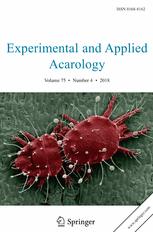Genetic variability of wildlife-derivedSarcoptes scabiei determined
by the ribosomal ITS-2 and mitochondrial 16S genes
Chun-Yan Li,Yin Sun,Yue Xie,Xuan Zhou,Xiao‑Bin Gu,Wei‑Ming Lai,
Xue-Rong Peng,Guangyou Yang

Abstract
Infestation by the ectoparasitic miteSarcoptes scabiei(Acari: Sarcoptidae) has important implications for global wildlife conservation and both animal and human health. Ribosomal and mitochondrial DNA sequences of parasites are useful to determine genetic diversity and to describe their likely dynamic evolution. In this study, we described the genetic diversity ofS. scabiei individuals collected from wild animals in China by sequencing the ribosomal ITS-2 and mitochondrial 16S rRNA genes. A total of 13Sarcoptes isolates of wildlife, coupled with one of rabbit origin, were subjected to genetic characteristics. After cloning and sequencing, 14 ITS-2 sequences and 12 16S rRNA sequences were obtained and analyzed. Further analysis of haplotype network and population genetic structure revealed that there were 79 haplotypes in ITS-2 (main haplotype H2) and 31 haplotypes in 16S rRNA (main haplotype C10). The phylogenetic trees showed some partial clustering by location and host, and the analysis of gene polymorphism may prompt that all isolates ofS. scabiei have a similar origin. We speculate that the genetic evolution ofS. scabiei may be related with that of the hosts, but more research is necessary to better understand the host-parasite co-evolutionary relationship inS. scabiei. These results provide new insights into understanding the population genetics and evolutionary biology ofS. scabiei and therefore a better understanding of controlling its infestation pathways worldwide.
copyright:©Springer Nature Switzerland AG 2018.
Exp Appl Acarol (2018). DOI:10.1007/s10493-018-0290-7
Read Full Text: https://doi.org/10.1007/s10493-018-0290-7